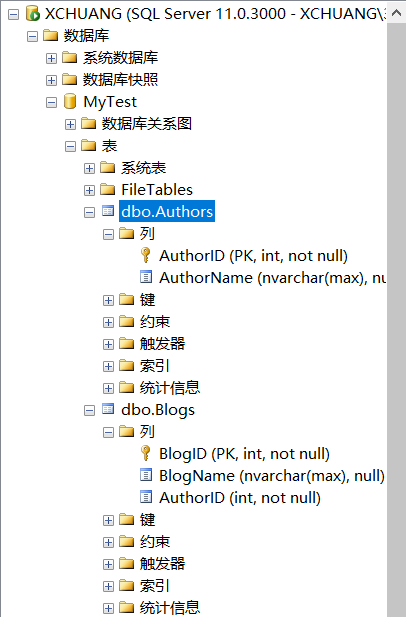如何使用 Entity Framework 的 DbContext,
如何使用 Entity Framework 的 DbContext,

本文转载自微信公众号「码农读书」,作者码农读书 。转载本文请联系码农读书公众号。
微软的 Entity Framework 是一个开源的 对象-关系映射 ORM 框架,它帮助我们打通了 数据库的数据模型 到 代码层的领域模型,Entity Framework 简化了应用程序对数据库的 CURD 操作,而且还向高层屏蔽了数据是如何持久化到数据库的。
说的具体一点就是 DbContext 充当了数据库到领域模型之间的桥梁,这篇文章我们将会讨论如何配置 DbContext 并使用 Entity Framework Core provider 对数据库进行 CURD 操作。
DbContext
DbContext 是 EF 中非常重要的一个组件,它扮演着 Database 的会话连接,使用它可以查询数据到你的 entitys 集合中,也可以通过它将 entitys 保存到底层数据库中, EntityFramework Core 中的 DbContext 拥有如下几个功能模块。
- 连接管理
- 查询数据
- 持久化数据
- 修改跟踪
- 缓存
- 事务管理
要想使用 EntityFramework,需要通过 nuget 引用 Microsoft.EntityFrameworkCore 包,可以通过 Visual Studio 2019 的 NuGet package manager 可视化界面安装 或者 通过 NuGet package manager 命令行工具输入以下命令:
- dotnet add package Microsoft.EntityFrameworkCore
接下来讨论下如何在 ASP.Net Core 中使用 DbContext 。
创建 DbContext
首先创建一个 CustomContext 类,并继承 Entity Framework 中的基类 DbContext,如下代码所示:
- public class CustomContext : DbContext
- {
- public CustomContext(DbContextOptions options) : base(options)
- {
- }
- protected override void OnConfiguring(DbContextOptionsBuilder optionsBuilder)
- {
- //Write your code here to configure the context
- }
- protected override void OnModelCreating(ModelBuilder modelBuilder)
- {
- //Write your code here to configure the model
- }
- }
可以看到 CustomContext 的构造函数中接受了 DbContextOptions 类型的参数,该类主要用于对 DbContext 做一些必要的参数配置,当然你也可以在 OnConfiguring() 中对 DbContext 进行配置,接下来的 OnModelCreating() 方法用于对 model 进行配置。
下面我在 CustomContext 中新增几个 DbSet
- public class CustomContext : DbContext
- {
- public CustomContext(DbContextOptions options) : base(options)
- {
- }
- protected override void OnConfiguring(DbContextOptionsBuilder optionsBuilder)
- {
- }
- protected override void OnModelCreating(ModelBuilder modelBuilder)
- {
- }
- public DbSet<Author> Authors { get; set; }
- public DbSet<Blog> Blogs { get; set; }
- }
- public class Author
- {
- public int AuthorID { get; set; }
- public string AuthorName { get; set; }
- }
- public class Blog
- {
- public int BlogID { get; set; }
- public string BlogName { get; set; }
- public int AuthorID { get; set; }
- }
注册 DbContext 注入到 ASP.NET Core 运行时
要想在 ASP.NET Core 中使用,需要将 CustomerContext 注入到 ServiceCollection 容器中,这里采用 SqlServer 作为底层存储,所以还需要在 NuGet 上引用 Microsoft.EntityFrameworkCore.SqlServer 包,接下来在 Startup.ConfigureServices() 中新增如下代码:
- public class Startup
- {
- // This method gets called by the runtime. Use this method to add services to the container.
- public void ConfigureServices(IServiceCollection services)
- {
- services.AddControllersWithViews();
- services.AddDbContext<CustomContext>(options => options.UseSqlServer("Data Source=.; Initial Catalog=MyTest; Trusted_Connection=Yes"));
- }
- }
DbContext 依赖注入
现在 CustomContext 已经注入到容器了,接下来就可以在 HomeController 中通过依赖注入的方式获取 CustomerContext 实例,下面的代码片段展示了如何去实现。
- public class HomeController : Controller
- {
- ILogger<HomeController> logger;
- private CustomContext dbContext;
- public HomeController(ILogger<HomeController> logger, CustomContext dbContext)
- {
- this.logger = logger;
- this.dbContext = dbContext;
- dbContext.Database.EnsureCreated();
- }
- }
上面的代码,我用了 dbContext.Database.EnsureCreated(); 来确保数据库已经成功创建,执行完这句代码之后,数据库将会生成 MyTest 数据库 和 Author,Blog 两张表结构,如下图所示:

接下来在 Index 方法中插入一条记录并查询,效果如下:

这就是配置 EF 所要做的所有事情,现在你可以利用 CustomContext 去所 CURD 操作了,DbContext 在概念上类似 ObjectContext,表示一个 UnitOfWork 组合单元,并且 EF 是DDD领域的一个实现案例,DbContext 的职责就是负责 应用程序 和 数据库 之间的交互,关于 Entity Framework Core 的更多特性,我会放到后面的文章中和大家一起分享。
译文链接:https://www.infoworld.com/article/3311737/how-to-use-the-dbcontext-in-entity-framework-core.html
评论暂时关闭